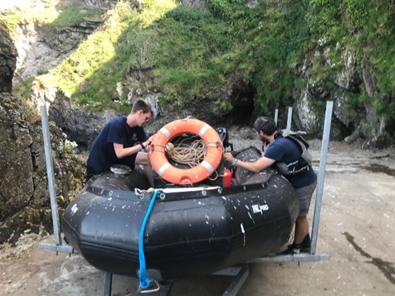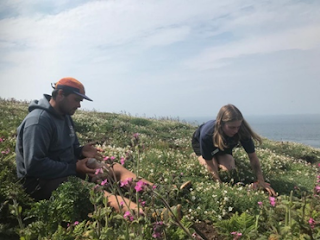Hi! I'm El, one of the long term volunteers on Skomer this July to September. After a day's delay due to poor weather conditions we arrived on Skomer to a warm welcome and warm weather. I've only been on Skomer a week but am already settled in and excited for what the next three months will bring.
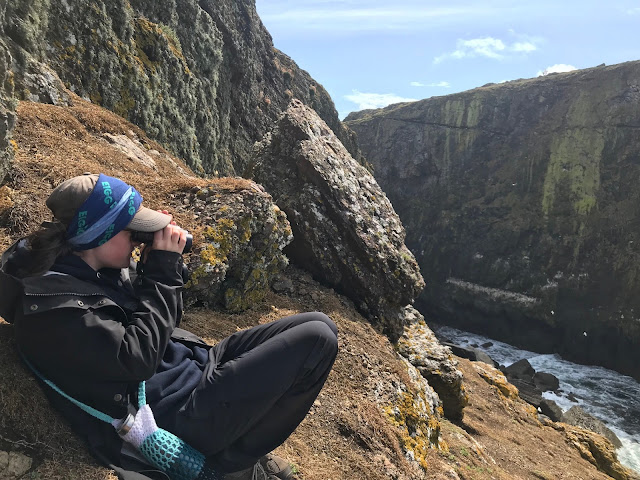 |
| El spotting kittiwakes at the Wick |
I studied Ecology and Conservation Biology. After graduating in 2021 I worked in practical conservation and habitat management at an environmental education center. Eager to get a chance to get more involved with species monitoring efforts, last summer I volunteered on the Isle of Eigg. There I developed a taste for island life, and I knew I wanted to continue working in places surrounded by the sea and as many birds as possible. I spent this spring and early summer on Skokholm, Skomer's neighboring island. I got the chance to work with a range of seabirds, including great black backed gulls, Manx shearwaters, storm petrels, puffins and fulmars.
Now on Skomer, I am getting into the swing of welcoming day visitors to the island and chatting with people about Skomer's awesome wildlife. I've also been cutting back fast-growing bracken and brambles from paths and signs, and have helped check biosecurity boxes set up around the island. I have enjoyed spending my free time so far exploring the island and watching my favourite gulls, kittiwakes, with their young. The highlight of the week was getting to see an incredibly fluffy Manx shearwater chick (thanks Emma!). I'm looking forward to starting seal counts as they begin returning to Skomer to pup.
Thanks for reading!
- El
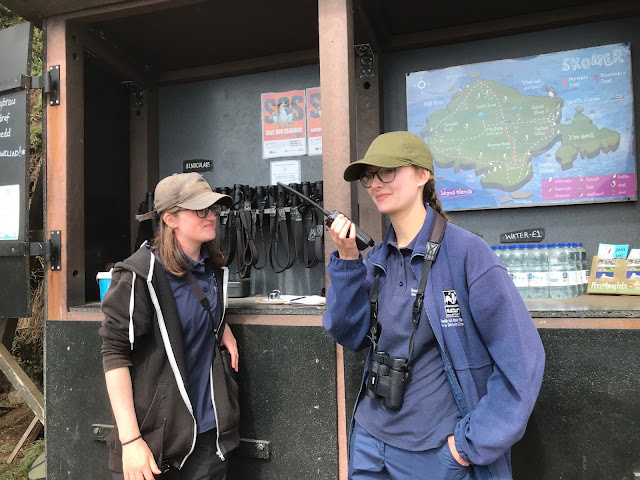 |
| El and Maddie running morning boats |
Hi - my name’s Maddie, I’m 23 years old and the second new Skomer Island long-term volunteer (LTV) for July-September. During my short time on the island I’ve already started aching all over from getting stuck into the hard work, including lugging visitors’ bags and brushcutting - but I’m still not used to the sheer amount of wildlife now on doorstep!
I’ve recently graduated from
Cardiff University with an integrated Master’s degree in Biological Sciences.
My degree choice was definitely influenced by my lifelong passion for the
natural world (especially birds!), but I wanted to do something completely
different to studying over the summer, with practical conservation work.
Alongside uni, I volunteered time to get involved with conservation efforts
whenever possible, including wetland bird surveying, nest box monitoring,
Great-crested Newt surveying, vegetation management at local wild spaces and
helping to set up my university’s ornithological society. Each of these
rewarding experiences have helped prepare me for this role, but there’s still
been a lot to learn!
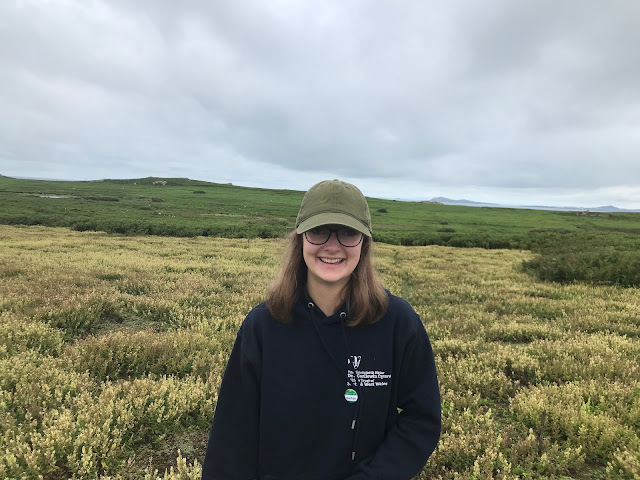 |
| Maddie on a morning wander |
After my initial arrival on the
island and getting a chance to take in all the wildlife, I soon jumped straight
into work. My tasks so far have included helping the day visitors and hostel
guests on and off the island, including giving welcome talks about Skomer –
these pushed me out of my comfort zone initially, but I now really enjoy
sharing facts and recent sightings with the visitors. I’ve also got involved
with other tasks, such as path clearance with a brushcutter, sorting out kit
and contributing to bird log (a relaxed daily chat with staff and guests to
record everything we’ve seen during the day).
In such a short space of time I
feel like I’ve already gathered many memories that will stick with me. Three of
the most exciting parts for me so far have been:
1.
Stepping outside at midnight to
hear the endless cacophony of thousands of nocturnal Manx Shearwaters calling
out as they flew above – the sound is incredible, and quite spooky!
2.
Spotting a leucistic (white)
Puffin bobbing on the water among its more colourful companions
3.
Seeing young birds all over the
island – Oystercatchers, Lesser Black-backed Gulls, a Curlew, Meadow Pipits,
Guillemots and many more!
 |
| Young Oystercatcher |
Throughout summer and as autumn
draws nearer, I’m excited to join in with more conservation work – including
monitoring the Atlantic Grey Seals during the pupping season in just a few
weeks time. Very soon I’ll also be starting a personal research project (once
I’ve finally narrowed down a study species!). Lastly, I’m really looking
forward to chatting with more guests, as well as getting to spend lots more
time with the friendly staff and researchers here.
Thanks for reading!
- Maddie
 |
| This young Puffin ended up in the Library after wandering into an open door, blown open at night |
